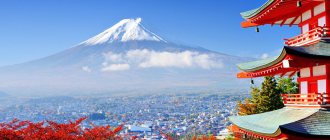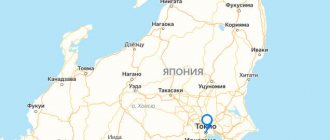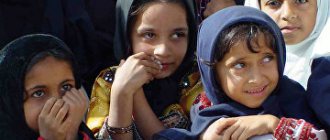Japan is located in the Pacific Ocean, or more precisely, on the Japanese archipelago, which consists of 6852 islands. This is an economically developed state with a high standard of living and unique culture. Although the economic and social sphere is at its best, Japan's population is not experiencing the best period in terms of growth.
However, this figure is decreasing every year: in 2021 alone it became less by 149,000 people. Forecasts for 2019 are also not reassuring: the countrymeters portal reports that natural growth will remain negative, the loss will be another 149,000. We need to figure out why such a developed state is experiencing difficulties with population growth.
Demographic situation
Demography studies the population, the patterns of its reproduction, distribution and composition. The fact is that Japan has low birth and death rates. CNN reports that the number of newborns fell to 921,000 in 2021, the lowest since 1899. Each woman gives birth to an average of 1.4 children, when with an increase in the population this figure is 2.1. The government intends to increase this number to 1.8. On the other hand, the mortality rate in Japan is also low. Since the country has developed healthcare and education for citizens, the Japanese can boast of almost the highest standard of living among the most developed countries. The standard of living also affects the average life expectancy , here the Japanese are ahead of countries such as Switzerland, Spain and Singapore (the world average is 71 years):
According to the census results at the beginning of 2019 , 126,048,221 people live in Japan (current as of April 2019). This allowed the country to take 10th place among other countries in terms of the number of citizens.
At the beginning 2020 , Japan's population dropped below 125 million and is 125,876,292 people (current as of June 2021).
Like throughout the world, 2021 turned out to be a very difficult year for Japan. Although it did not affect the country much, the population has decreased and at the beginning of 2021 : 125,620,000 people.
average life expectancy
- men – 79 years old
- women – 85.7 years
This means that Japan is an aging nation. The percentage of residents of retirement age is increasing (22.9%), and fewer and fewer are children and adolescents (only 13.1%). The remaining 64% of residents are of working age.
social burden is created in Japanese society . To provide for disabled people, it is necessary that able-bodied residents produce one and a half times more services and goods than they need themselves.
The ratio of men to women is:
- 0-24 – 105 men per 100 women
- 25-69 – 101 to 100 respectively
- 70+ – 69 to 100
Geographical location of Japan
Geographically, the state consists entirely of islands located in the eastern part of Asia.
97% of the area is formed by the largest of them:
- Honshu;
- Hokkaido;
- Kyushu;
- Shikoku;
- Okinawa.
The remaining 3% is made up of groups of Pacific islands: Nampo, Izu, Ogasawara, Kazan and others.
History of development
With the rise to power of a military government in the 17th century, the Tokugawa Shogunate, Japan maintained a policy of closed borders that lasted two centuries. As a result, by the mid-19th century the country was a fragmented, closed agricultural periphery. By this time, it had become impossible to ignore global development trends and the penetration of Western republics into the region.
The deterioration of the internal economic and social situation led the country to a coup - the Meiji restoration (enlightened rule).
From this moment on, a new stage in the historical development of Japan begins, associated with the following factors:
- The abolition of the shogunate and the return of the power of the monarch.
- Opening borders: introducing Western technologies, developing foreign trade relations.
- Reorganization of the army and navy along the lines of Germany and Great Britain.
- Reforming the internal situation of the country.
This policy brought the country to the position of a developed world power by the beginning of the 20th century. The position of the aggressor in the Second World War and its consequences (destruction, indemnity, loss of territories, military power and independence) threw the country back from the general line of development for some time. This made its own adjustments to the history of the country.
In the post-war period, all funds were spent on restoring the state, and not on the arms race and participation in military clashes of the Cold War. The result was record economic growth in the 50-70s of the 20th century. The Japanese economic miracle returned the country to a place among world leaders that remains to this day.
Area and boundaries
The area of the country is represented by the sum of all its constituent islands and water surfaces. This number is 377,930 sq. km.
Where Japan is located on the world map shows us the complete absence of land borders.
The closest neighbors are separated by seas and straits:
- China - East China Sea in the southwest;
- Korea - the Sea of Japan in the west;
- Russia (Sakhalin Island and the Kuril Islands) - the La Perouse Strait and the Kunashir Strait in the north.
Capital
The main city of the country is Tokyo, located on the largest and most populous island of Honshu. More than 13 million people live here.
Tokyo is the center of:
- production of high-tech science-intensive products;
- the location of the main offices of international foreign corporations;
- education;
- finance (one of the largest stock exchanges in the world is located);
- politics and administration.
Political regime
Japan is a democratic state with a constitutional monarchy form of government. This implies the nominal supremacy of the emperor, whose role is to perform representative functions.
The de facto head of state is the Prime Minister, head of the Cabinet of Ministers, the country's executive body.
The expression of the will of the people, the holder of legislative power and the bearer of state sovereignty is the parliament.
The composition is represented by two chambers:
- House of Representatives, consisting of 480 deputies elected for 4 years.
- The House of Councilors, consisting of 242 deputies elected for 6 years.
State symbols
The flag of Japan is a red circle on an azure background. It is a symbol of the country's rise in the 19th century. Along with the anthem and flag, the seal of the emperor is a state symbol. Her imprint is a chrysanthemum with 16 petals.
Japan also has many officially recognized symbols of the country associated with animals, plants and nature.
First of all this:
- Mount Fuji;
- sakura;
- Japanese stork;
- Tanuki (raccoon dog), etc.
The language of the country is absolutely special, having several dialects. It is considered one of the most difficult; it can take a whole year to learn just the alphabet and counting system. The hieroglyphic writing, which is unusual for the European eye, is especially difficult to perceive.
The country's official currency is the yen, which is one of the world's reserve currencies. Japanese money is represented by coins and paper bills. The smallest coin is one yen, the largest bill is 10,000 yen, or one mana.
Economy
Rapid economic growth 50-70. not without government intervention. But at present, such trends cannot solve the crisis, so it is proposed to weaken the regulation of foreign exchange and financial markets, privatize the public sector, etc.
Financially, Japan is a global creditor, plays a leading role in the world and has a dominant position in Asia. On economic issues, Japan maintains an active dialogue with the US President.
In terms of production, the resource-poor country occupies a leading position in industry.
The leading industries here are:
- robotics;
- electronics;
- machine-tool, machine-tool, shipbuilding.
Agriculture is represented by rice growing and fishing. The country is a leader in the production and processing of fish and seafood in the world.
Relief and climate
The volcanic and mountainous origin of the islands, the constant movement of the tectonic plate leads to frequent earthquakes in the region.
The climatic zone is represented by four distinct seasons.
Depending on the territory, temperature fluctuations occur on average:
- From –15 °C in the north of Hokkaido, to +16 °C on the southern islands in winter.
- From 25 °C in the north, to 30 °C in the south - in summer.
The weather in Japan is influenced by its island position, proximity to the ocean, high humidity and seasonal winds.
Emigration policy of the Japanese government
Developed countries like the USA, Germany and Canada have found a solution to the problem of the aging population by revising their emigration policy. Unfortunately, the Japanese do not consider this option - 99% are indigenous people. These people care about preserving ancient traditions and culture, keeping the crime rate low, and preventing crimes by citizens. Most foreigners are not familiar with the culture and customs, so they do not take root here.
The majority of Japanese immigrants are Korean (0.5%) and Chinese (0.4%).
Interesting Facts
This is interesting:
- A popular tourist destination is Aokigahara, or the suicide forest. According to legend, weak relatives whom they could not feed were left here to die.
- A distinctive feature of the Japanese greeting is bowing instead of shaking hands. Moreover, there are a considerable number of rules on how low the bow should be or how many times you need to bow.
- To this day, you can order dinner with a geisha as an attraction. But you can’t relax here either. Even holidays in Japan are strictly regulated and surrounded by a set of rules, especially in relation to your escort.
- Perhaps it is precisely because of the huge number of restrictions and regulations that teenagers in Japan are extremely radical in their appearance. Strange clothes, multi-colored hair and provocative behavior are allowed until you get a job.
- The Japanese are very reserved and non-confrontational. Showing aggression here is considered a loss of dignity.
Japan population, density
Density determines how many people live in one square kilometer of territory. According to the UN Department of Statistics, the country has an average population of 333 people per square kilometer. Despite the fact that the country is considered densely populated, some areas are not densely populated - only 70 people. The number of urban residents and those who inhabit coastal areas is about 500 people, and some regions number even 5.5 thousand.
Every year, thousands of young Japanese decide to move to cities, increasing the level of urbanization. There are 11 million-plus cities in the country, the most populated are:
- Tokyo - 13.7 million
- Osaka – 2.6 million
- Nagoya – 2.2 million
Features of the ethnic composition
Unlike many other states, Japan has an almost entirely mononational population. The racial composition has remained unchanged for many hundreds of years - indigenous people make up more than 98% of the country's inhabitants. In addition, there are surprisingly few migrant workers on the islands ; Koreans, Chinese, Peruvians and Brazilians are the most likely to come to work in Japan.
The indigenous nationality is divided into several ethnic groups. The ancient Japanese state arose in the 3rd-4th century on the territory of the Yamato tribal union. Along with representatives of this tribe, the basis of the Japanese nation were the Ainu and Ryukyu peoples, who also lived on the islands from ancient times.
Japanese
State policy, however, from the very beginning avoided emphasizing ethnic differences, and therefore the Japanese perceive themselves as a single people, with a single culture, speaking the same language. The Japanese language has dozens of dialects , quite different from each other, especially on the northern and southern islands of the archipelago.
Literary Japanese was created in the nineteenth century based on the Tokyo dialect, is used in all educational institutions and allows speakers of different dialects to easily communicate with each other.
Religious Beliefs
Most Japanese people identify with a particular religion, but this cannot be said to play any significant role in their daily lives. The dominant religions are Buddhism and Shinto, often a mixture of these two religions and practices. The All Japan Buddhist Association is the largest religious organization. Christians make up no more than 3%, representatives of Islam and other religions in total no more than 7% of the population.
Caste survivals in modern times
Despite the generally successful strengthening of the unity of the Japanese nation, the country still has not eliminated the tradition of caste discrimination. It’s not customary for the Japanese to talk about it, but at least a million people are considered in society to be a caste of outcasts - the Burakumin.
This caste developed many centuries ago on the basis of religious ideas about purity and included, on the one hand, people who had committed criminal offenses, and on the other hand, representatives of “unclean” professions associated with blood, death and other dirty work (butchers, tanners, scavengers, executioners, even surgeons, undertakers)
Although the caste system was officially abolished almost 150 years ago in 1871, the areas and towns specifically designated for these people have not gone away and still exist. Descendants of Burakumin experience problems with admission to prestigious educational institutions, with employment in successful companies, they have practically no chance of marrying a representative of another class, so they often leave the country and start families with foreigners who are not subject to local prejudices.
Demographic Projections for the Japanese
According to the National Institute of Research's Japan Population Projections: 2021 to 2065, the country will have 88.1 million people living in 2065—nearly two-thirds the number today. Japan's population will continue to age rapidly, with more than 25.5 percent of the population being 75 years of age or older. It is estimated that 547,000 will reach the age of 100 - ten times more than in 2015.
Optimists argue that the situation in the land of the rising sun will return to the same number of inhabitants as 65 years ago. But the situation with the aging population is significantly different. Japan is already becoming a shrinking society. The main reason is the natural decrease, that is, the difference between birth rates and deaths. Also, Japanese women began to get married only at the age of 30, which affects the birth of children. Although the government is trying to support young families, this is not easy, because a significant part of the budget is allocated to older people.
How are the Japanese different?
The Japanese are characterized by workaholism, pedantry and scrupulousness in their work. Although the working day in the country is officially eight-hour, few people comply with this norm. Employees often stay at work for 12 hours.
A peculiarity of their appearance is the average height of the Japanese, which differs from the European one. At the beginning of the 20th century it was 150 cm for men and 145 cm for women. Today there is an increase in this figure - the average Japanese reaches 170 cm.
Average costs
Average base cost from conception to 1 year of life
| Expense name | Average cost in JPY |
| Prenatal examinations, laboratory tests and diagnostics (average 14 visits) * | 98 000 |
| Hospitalization (normal birth) | 350 000 |
| Cloth | 120 000 |
| Diapers (2200 for 2 packs per month x 12 months) | 26 400 |
| Milk/formulas** | 120 000 |
| Baby wet wipes, cotton | 8 400 |
| Other (bottles, sterilization kit, changing mats, clippers, bath towels and other baby products) | 60 000 |
| Furniture (crib, mats, stroller, car seat, etc.) | 120 000 |
| Immunization and screenings | Free |
| Maternal and Child Health Classes | Free |
| Total | 902 800 |
In some cities, there is a subsidy to pay for medical care for children, both during hospitalization and on an outpatient basis. Coverage varies for each city, but it even includes medications and diagnostics. Immunizations are free, except for the flu vaccine, which costs about 2,000 yen.
How Japan is aging
The birth rate in the Land of the Rising Sun fell last year to its lowest level in 120 years of observation. Japan's demographic problems, and above all the rapid aging of the Japanese people and the declining birth rate, have been talked about for many years. However, now we are talking about the fact that if the dangerous trend cannot be reversed, the Japanese may disappear as a nation altogether.
SERGEY MANUKOV
The extinction of the Japanese is a long process, but problems for the economy and finances associated with demography are already rapidly growing. First of all, this is a labor shortage and a huge burden on the country’s financial system.
Both the government and Japanese business are looking for a way out of this difficult situation.
The authorities, for example, decided to change migration policy and open doors to foreign workers. As for business, Japanese businessmen are increasingly employing older people who are retiring. At the same time, demographers propose raising the retirement age.
But scientists and engineers believe that the Japanese do not need migrants, but an innovation boom and general automation, which will close the gaps in the labor market.
There are many opinions and options for solving the problem, but it is so complex and multifaceted that it is extremely difficult to find the right solution and minimize negative consequences.
Record holders for diapers
The Japanese have already begun to get used to demographic records. Unfortunately, so far they are only negative. Another such anti-record became known at the very beginning of summer. In 2021, the birth rate in the Land of the Rising Sun dropped to its lowest level since records were recorded (since 1899). For the second year in a row, fewer than a million people are born. Mortality has reached a post-war high. Last year, 946,060 children were born in Japan and 1,340,433 people died. As a result, the population dropped by an impressive 394,373 people.
In recent years, the birth rate in Japan has not kept pace with the death rate.
Photo: Reuters
The birth rate in Japan has always exceeded the death rate. In 2016, parity was established between them, and last year the mortality rate took the lead. At the same time, the difference compared to the previous year increased by 3%.
Scientists from the National Research Institute of Population and Social Security, dealing with demographic problems, have come to the conclusion that if everything is left as it is, the Japanese are in danger of completely disappearing as a nation. And although this will not happen tomorrow, but only on August 12, 3776, the very fact - albeit theoretical - of the possibility of such an outcome, of course, causes anxiety on the Japanese Islands.
Demographic forecasts are made every five years in Japan. Moreover, each new forecast is worse than the previous one. Scientists have been warning for years that the current situation could end in economic and social disaster.
In 2021, the Statistics Bureau of Japan estimates that there were 126.714 million Japanese people. Demographers have calculated that
Japan's population may decline to 100 million people by 2053, and to 88 million by 2065. The number of Japanese under 14 years of age is declining at a rate of 1 person per 100 seconds.
“If the rate of decline in the number of children continues,” says Hiroshi Yoshida, an economics professor at Tohoku University, “the country will celebrate Children’s Day for the last time on May 5, 3011.”
On the other hand, life expectancy, one of the highest on the planet, will continue to increase. Now, according to the Ministry of Health, Labor and Welfare of Japan, both Japanese men and women are second only to Hong Kong residents in this indicator.
In 2021, life expectancy for men in Japan rose to 80.98 years, and for women to 87.14 years. According to forecasts, by 2065 it will reach 84.19 years for men and 90.93 years for women.
Every fourth resident of the islands (26.7%) is over 65 years old. In the USA this figure is much lower - 15%. The number of elderly people in the Land of the Rising Sun is constantly growing. So, last year it increased by 3.7% compared to 2011, and by 2050 it could reach almost 40%.
A special conversation about long-livers. In the fall of 2021, the number of Japanese over 90 years old exceeded 2 million for the first time.
The number of Japanese centenarians has been growing for almost 50 years
Photo: THE YOMIURI SHIMBUN / AFP / EASTNEWS
Among the 127 million Japanese people, 67,824 are centenarians, over 100 years old. In 2016, there were just over 65 thousand. Nowhere on the planet are there so many centenarians as in Japan. For every 100 thousand Japanese there are 4.8 centenarians. In the USA, this figure is half as high – 2.2.
In 1963, 153 centenarians were registered in Japan. By 1998, the number of centenarians in Japan exceeded 10 thousand. A truly sharp jump occurred in recent years, when the number of centenarians increased fivefold in less than two decades! The 40 thousand mark (40,399) was surpassed in 2009. Last year marked the 47th consecutive year of growth in the number of people celebrating their 100th birthday.
The traditional Japanese low-fat diet, consisting mainly of rice, fish and vegetables, is to blame. The growth of the club of centenarians in recent years has also been facilitated by a highly developed and relatively inexpensive healthcare system and large pensions.
There is further evidence of Japan's rapid aging: the number of adult diapers sold has outpaced the number of children's diapers since 2011. Moreover, the difference is constantly increasing.
Time bomb
The term “demographic time bomb,” meaning a decrease in the birth rate and an increase in life expectancy, did not appear yesterday, of course. Many countries are facing problems with population decline or slower growth. Humanity is aging. In developed countries this happens much faster due to low birth rates and high life expectancy. But nowhere is the population aging at such a rate as in Japan. The day is not far when it can rightfully be renamed from the Land of the Rising Sun to the Land of Old Men.
An aging population brings numerous challenges. The authorities have to spend more money on health care and pensions, which puts severe pressure on the financial system. The number of young people serving old people is declining. The reduction in the working-age population and taxpayers leads to economic stagnation.
An aging population is a major headache for the Japanese government.
Photo: Reuters
“An aging population means higher costs for the government, smaller pension and social security funds, fewer caregivers for the elderly, and ultimately fewer younger workers,” explains Harvard sociologist Mary Brinton, a demographic time bomb.
For a long time it seemed that there was no reason for alarm.
Japan's population grew rapidly in the 20th century. The numbers speak for themselves: in 1900 there were 44 million Japanese people, and in 2000 there were already 128 million.
The first problems began to appear already in the last third of the last century. They were then expressed mainly in the birth rate. In the 70s of the last century, Japanese women had an average of 2.1 children, and now they have 1.41, which is significantly below the population replacement level of 2.08. In the United States, the birth rate is also a record low - 1.76, but it is still significantly higher than in Japan.
In Russia, by the way, whose population as of January 1, 2018 was 146.877 million people, the birth rate is about the same as in America: it peaked at 1.777 in 2015, after which it began to decline and dropped last year to 1.621.
The birth rate in our country has fallen to its lowest level in the last decade. Suffice it to say that Russian women gave birth to 1.69 million children in 2017, that is, 203 thousand less than in the previous year. In 2016, the population of Russia increased by 5.4 thousand people, and last year it decreased by 134.4 thousand.
The government of Shinzo Abe has set a goal of raising the birth rate to 1.8 by 2025 in order to stabilize the population at 100 million by 2060. However, this will be extremely difficult to do. Population bombs are difficult to defuse because they take decades to build.
In Japan, this process began shortly after the end of World War II. In the early 1950s, Prime Minister Shigeru Yoshida (1946–1947, 1948–1954) considered economic recovery to be the main task. With his blessing, a kind of social contract between employers and workers was established in the country: the former undertook to provide the latter with jobs, and the latter, in exchange for this, remained faithful to the former, that is, they did not change their place of work. Economists believe that Yoshida is at the origins of the “Japanese miracle”, which made Japan the third economy on the planet.
But rapid economic development has not been without negative consequences. In the early 50s, the birth rate in the Land of the Rising Sun, according to the UN, was 2.75. Business demanded more and more dedication from the Japanese. It is not surprising that in the second half of the last century a decline in the birth rate began, which continues to this day. According to one of the most gloomy forecasts, the birth rate will continue to decline and by the middle of this century will drop to 1.35.
A lot has changed now. This includes the long-standing practice of working in one place. These days, more and more Japanese are moving to other companies in search of more attractive working conditions and high salaries. The number of such “defectors” has been growing for the seventh year in a row. According to Japan's Ministry of Internal Affairs and Communications, 3.11 million people changed jobs last year. A record number of defectors (29.7%) saw their salaries increase in their new jobs by more than 10%, according to Recruit Career Co.
You can cry too
Japanese authorities and politicians are making considerable efforts to solve the demographic problem, and some of the efforts may seem strange.
Thirteen prominent male politicians, including Eikei Suzuki, the governor of Mie Prefecture, for example, recently announced support for the We Love Children! project. The project was launched in 2021 with the goal of improving society's attitude towards... the crying of infants in public places. Ultimately, the initiative's authors hope, this will lead to an increase in the birth rate.
To solve the demographic problem, Japanese children were allowed to cry in public places
Photo: The Asahi Shimbun via Getty Images
“There is still an atmosphere in Japanese society that makes parents of babies crying in public places feel guilty towards others,” Eikei Suzuki explained to Kyodo News the goals of the project. “We want to change this situation.”
The attitude towards children's noise in some areas of the country is so intolerant that local authorities, for the sake of the peace of mind of citizens, do not want to lay out parks or build nurseries and kindergartens.
It is not surprising that there is a shortage of preschool institutions in the Land of the Rising Sun. For example, in April 2021, the queue for public kindergartens and nurseries was 26,081 people. Many Japanese with small children believe that enrolling a child in such an institution is more difficult than enrolling in a prestigious university. It is not surprising that there is a high demand for female workers in such institutions. By the way, recently one of them publicly apologized for... getting pregnant before the due date set for her by the director.
The authors of the “We Love Children!” project are improving their attitude towards children’s crying. through propaganda.
Politicians appealed to the owners of restaurants, cafes, shops and other public institutions with a request to hang notices at the entrance with the following content: “You can cry here.”
Another measure of the Abe government, indirectly aimed at increasing the birth rate, is the reduction of the age of majority planned for 2022 from 20 to 18 years, the first, by the way, in 140 years. It means, for example, that Japanese men and women can get married two years earlier, take out loans, etc.
However, you can't legally celebrate coming of age on Coming of Age Day, celebrated on the second Monday of January, with a couple of glasses of sake. The age reduction does not apply to gambling, smoking and drinking alcohol.
Changing the age of majority is intended to serve not only to increase the birth rate, but also to activate young people in society and the economy. Recall that in 2015, Tokyo lowered the voting age from 20 to 18 years. This allowed 2.4 million young Japanese aged 18 to 20 to take part in elections to the upper house of parliament, the House of Councilors of Japan, in 2016.
Free yourself from the chain
“They are a real treasure,” Shinichiro Tsukada, owner of a small construction company specializing in plastering, recently told Reuters. “Our population is aging and workers are becoming increasingly difficult to find. There are not enough workers, so it is becoming increasingly difficult to carry out construction. We have no other choice, we need to open doors for them.”
Mr. Tsukada talks about 22 workers, who make up half of his company's staff, who have Chinese and Vietnamese passports rather than Japanese ones. Without them, he would have had to close the company.
Japanese businesses struggle to find replacements for aging workers
Photo: Reuters
The Japanese authorities approach the problem of foreign workers in the country very carefully, because this is a very sensitive and sensitive topic for the Japanese. There are few foreigners in the Land of the Rising Sun. Any proposal to open borders to migrants from other countries in order to replenish the decline in the working-age population has always provoked extremely harsh criticism in society.
The origins of this attitude should be sought in distant history, when Japan was closed to all gaijin (foreigners) and practiced sakoku (“country on a chain”) - a policy of self-isolation.
It was the American commander Perry who had to “discover” the Land of the Rising Sun in 1853. By threatening to bombard Kyoto, then the imperial capital, he forced the Japanese to sign a trade treaty with America. The US example was soon followed by France, Great Britain and Russia.
However, times, and with them the attitude of Japanese society towards foreigners, albeit very slowly, are still changing. The already high demand for workers is increasing as the 2021 Olympics, which will be held in Japan, approaches and many sports and infrastructure facilities need to be built.
Despite changes noticeable even to the naked eye in the attitude of the Japanese towards foreigners, wariness remains. The Japanese remain fearful that an influx of workers from overseas will disrupt social harmony, increase competition in the labor market and negatively impact historical traditions.
“I think we will continue to need foreign workers,” summed up the fears of his compatriots, 28-year-old news agency employee Hiroki Kojima, “but when I hear the word “migration,” I immediately worry about all the good things that exist in Japan. For example, I am afraid that they will undermine public safety and stability in the country.”
Japan before its heyday
In June this year, the Japanese government announced the introduction of work permits for foreigners valid for five years. At this stage, they extend to agriculture, construction, hospitality, elderly care and shipbuilding. If the experiment is successful, the list of economic sectors will be expanded.
Tokyo intends to allow foreign workers to remain in the country if they pass certain tests, primarily Japanese language proficiency, and even to bring family members to Japan.
“We have reached a point beyond which, if we do not start thinking about migration, the future of Japan will be in danger,” says Toshihiro Menzu, executive director of the Japan Center for International Exchanges.
The number of foreigners in Japan has been growing steadily in recent years and reached 1.28 million last year, or about 1% of the country's population. Over the past ten years, it has increased 2.5 times (486 thousand in 2008), and compared to 2016 it increased by 18%.
The biggest increases were in two categories: students, who are allowed to work 28 hours a week, and foreigners in Japan on a five-year technical exchange program after which they are required to return home. The program is designed to train workers from countries such as Vietnam and the Philippines so they can return to their home countries and apply the knowledge and skills they acquired in Japan. In practice, however, it works more to the benefit of Japanese businessmen, who fill jobs with foreigners.
As of October 2021, there were approximately 258 thousand foreigners working in Japan, up 22% from 2021. Most of them are Chinese - 29%.
According to a 2021 survey conducted by NHK radio, 51% of respondents believe that restrictions on foreign workers should remain at current levels. In 1992, there were slightly more such people - 56%.
Japanese fears about foreigners are well documented in the best-selling book Future Timeline (2017). The author of the book, a journalist for the conservative newspaper Sankei Masashi Kawai, believes that Japan should not weaken immigration laws, but become a more compact and more efficient country.
“The reception of huge numbers of migrants has led Europe to such terrible consequences as terrorist attacks, unrest and the rise of anti-migrant movements,” he writes. “Opening borders to foreigners in Japan will split our society and lead to similar consequences.”
There are many opponents of the open door policy in the Land of the Rising Sun, but all Japanese understand that they cannot do without foreigners. Perhaps the need for foreign workers is especially strong in the example of Japanese agriculture. Many farmers simply cannot find Japanese workers.
54-year-old Souji Sawaura's farm in Gunma Prefecture, for example, employs 24 Thais and Vietnamese. Sawaura is in favor of issuing permits for foreigners to work in agriculture, but he emphasizes that only qualified workers should be allowed into Japan, so that the story of the Brazilian Japanese, who came in the 90s of the last century and in the 2000s as special workers, would not be repeated permissions. The vast majority of them did not have sufficient qualifications. They lost their jobs during the 2008 crisis and were forced to return to their historical homeland.
The government does not intend to open its doors wide to foreigners, Shinzo Abe reassures worried compatriots. Statistics on refugees confirm the prime minister's words. In 2013, Tokyo agreed to accept six refugees, in 2014 - 11, and in 2015 - 27 people! In 2021, 10,901 people applied to the government to request permission to live in Japan. 28 of them received refugee status.
Last year, the number of requests for refugee status almost doubled to 19,628, but about one in a thousand was lucky. 20 applicants became refugees. Mostly neighbors from Southeast Asia want to live in Japan. The share of residents of hot spots (Syria, Afghanistan, Iraq, Yemen, Congo and South Sudan) in total amounted to only 1% of applications, the number of which, by the way, increased by 1600% compared to 2010.
Japan is just beginning to understand another big problem that is already well known in Europe: how difficult it is for foreigners to integrate into Japanese society. One of the biggest obstacles, according to Meiji University professor and migration expert Keizo Yamawaki, is language. The government hopes to solve this problem by opening Japanese language courses.
Chinese plasterer Wang Jinbao, 48, who has worked for Tsukada's company for six years, says he would happily stay with his family in Japan, where he can earn twice as much as at home. He is sure that knowing the Japanese language helped him adapt to the country and make friends.
Distinctive feature
It is much more difficult to change the attitude of an entire generation of young Japanese to work and to life in general. When it comes to fertility, the first thing we have to talk about is sex. Young Japanese men and women have big problems with him.
The sexes in Japan are not moving closer together, but increasingly diverging. According to a 2021 study by the National Population Institute, 70% of Japanese men and 60% of Japanese women live without partners. At the same time, almost 42% of men and 44.2% of women do not hide the fact that they are not interested in sex and even have an aversion to it. In 2010, 36.2% of Japanese men and 38.7% of Japanese women had a cool attitude towards sex.
Nearly two-thirds of Japanese do not have partners
Photo: Reuters
“The main reason for the decline in the birth rate in Japan, without a doubt, is the reluctance of the Japanese to have sex,” says Kunyo Kitamura, head of the Japan Family Planning Association. “If we add to this the growth in the elderly population, then there is a serious demographic imbalance.
The increase in the number of married couples who are officially recognized as asexual is also very alarming. This means they have sex less than once a month.”
Politicians are fighting as hard as they can to increase the birth rate. For example, the Secretary General of the ruling Liberal Democratic Party Toshihiro Nikai recently called childless Japanese selfish and called on Japanese women to have children and contribute to the prosperity of the country.
“Before the war, during it and after, no one said that it is better not to have children because they cause too much trouble,” Nikai said. “Today, people are dominated by selfish thoughts. Many people believe that it is better without children, but many children are necessary for everyone’s happiness. Only in this case will our country prosper and develop.”
Koichi Hagiuda, a close friend and assistant to Prime Minister Abe, also believes that women have a responsibility to bear children. MP Kanyi Kato believes that every family should have at least three children.
But there are also politicians, and it seems that Japanese Prime Minister Shinzo Abe is one of them, who believe that marriage and children are a private matter for every Japanese. Abe’s position, by the way, did not surprise anyone, because he himself has no children.
Crowded trains
The lack of sex in Japan is rapidly turning into the same calling card of the country as sumo, sake or Fuji. However, the weak interest in sex is explained simply. The national characteristics of the Japanese have nothing to do with it. Every year young people devote more and more time to work and less and less time to social life. They work more because they want to survive economically.
The Japanese made the choice between work and sex in favor of work
Photo: Reuters
The Japanese work on average 16 hours a day. Japanese women are quickly catching up with men in this regard. Some families have the strength and perseverance to deal with the problems that arise from such a life in family life, but the majority go with the flow and push family life to second or even more distant place.
Forced diligence at work leads to karoshi. This word in Japanese means “death from overexertion at work,” or, more simply, numerous suicides.
In October 2021, scientists examined the working conditions of Japanese people. As a result of a survey of 10 thousand people, it turned out that more than 20% of them overwork at least 80 hours a month. For comparison, 16.4% of the working population in the United States work overtime, with an average workweek of 49 hours.
Overtime work explains a fact of Japanese life that is surprising to foreigners: the last trains are almost everywhere overcrowded. The Japanese return home late to sleep for a few hours, and then rush back to work in the morning.
But there comes a time when the duration of work does not translate into the volume of additional products, that is, processing after a certain point loses its effect. The government convinces the Japanese of the need for rest. The authorities promote timely leaving work and at least one day off a week.
Businesses are also struggling with overtime. Advertising agency Dentsu, for example, forces employees to take at least five days off every six months. To ensure that they go home, the lights in the office are turned off at 10 pm.
This decision was made after the suicide in 2015 of 24-year-old Matsuri Takahashi, who accumulated 105 hours of overtime in one month. The terrible tension led the girl to jump out of the window of her dorm room. There are dozens of such cases.
Demographers and economists are alarmed by the declining ratio between the working population and pensioners. In 2015 it was 2.1, and by 2065, according to forecasts, for every pensioner over 65 years old there will be 1.2 working Japanese. This is very little.
As the number of workers per pensioner decreases, the load on the pension system, which is already bursting at all the seams, also increases. There is no talk yet about raising the retirement age, which is 65 in Japan for both men and women. The authorities are well aware of how unpopular such measures are. In addition, pensioners can work longer without formally increasing the retirement age. This allows not only to reduce the burden on the pension system, but also somewhat alleviates the labor shortage.
In Japan, both men and women retire at 65
Photo: EPA/Vostock Photo
Business is actively helping the government with this. More and more companies are allowing their employees to continue working after retirement. The government encourages employers to provide pensioners with all kinds of subsidies and benefits.
In 2021, almost every fourth pensioner (23%) continued to work. Nowhere else in the G7 are there more working pensioners than in Japan. In the USA, for example, according to the Organization for Economic Co-operation and Development (OECD), 19% are working pensioners.
Another solution to the labor shortage problem, which is supported by opponents of allowing foreigners into Japan, is automation and robotization of industrial production.
Old robbers
The aging of the Japanese has led to major changes in their psychology and social life. Take, for example, respect for the elderly, which has recently been weakening almost every day.
The Japanese word for many centuries has been ubasute, which can be translated as “getting rid of grandma.” Now it is returning to everyday life.
Nowadays, it means that the Japanese hand over elderly relatives to hospitals or special institutions, that is, they actually abandon them. And not because they suddenly became heartless egoists. The main reason is that young people are not able to support the elderly.
There are, of course, other reasons. As life expectancy increases, children who have to care for frail old people, themselves increasingly over 70, often need care themselves.
So far, the trend cannot be called nationwide. Social workers estimate that last year the number of such cases amounted to several hundred. It is alarming, however, that it has been continuously growing in recent years.
One of the consequences of ubasute is another problem: as a result of the rapid increase in the number of elderly prisoners, prisons are effectively turning into nursing homes. Almost every fifth crime or offense in the country is committed by older people. Mostly old people steal. Most often in stores.
Old robbers differ from their younger colleagues in that they prefer practical things - food and clothing - to luxury items. Almost 70% of thefts by pensioners involve food. Elderly prisoners cause a lot of trouble for guards. They have to be bathed and dressed.
According to experts, the conditions in Japanese prisons are too good to hope that yesterday's prisoners will come to their senses when released. After release, they are usually looked after by younger relatives, but recently ubasute has significantly influenced this tradition. Increasingly, expenses and even simple loneliness are forcing older people to return to prison.
It's not hard to go to jail: stealing a sandwich from a store carries a two-year prison sentence. The old robbers are quite happy with such a severe punishment. In addition to bars on the windows, they receive a free roof over their heads and free food for two years.
Six years ago, the number of thieves over 65 caught in Tokyo exceeded the number of young thieves for the first time. Law enforcement officers detained 3,321 pensioners for theft. There were 3,195 teenagers caught in thefts. Almost every fourth thief in the capital was a pensioner. The same picture is observed throughout the country.
In 1989, when Japan began keeping age statistics on thefts, only 336 elderly thieves were arrested in Tokyo. The psychological, as they say now, level - 10 thousand nationwide - was overcome in 1999, 20 thousand in 2004, and 30 thousand in 2013.
The number of Japanese caring for the elderly is declining, but the number of elderly Japanese forced to live alone is constantly increasing. Sometimes apartments become crypts for them. Neighbors most often find out about the death of old people by the smell of rotting. Elderly Japanese people negotiate with their neighbors about signs by which they can recognize that they are no longer alive. For example, if the windows are closed with curtains in the morning, that means you need to break down the door.
“If my windows are closed,” 91-year-old Chieko Ito explained to the New York Times, which was interested in how Japanese centenarians live, “then that means I’m dead.”
Photo: Reuters











